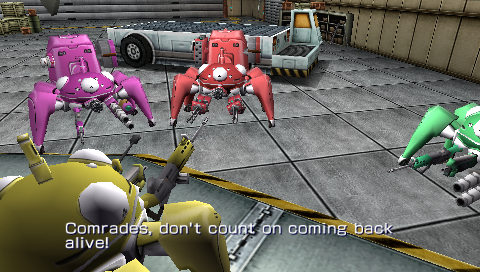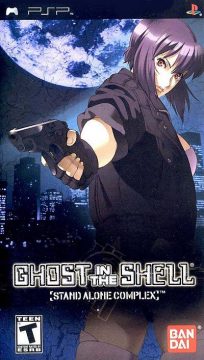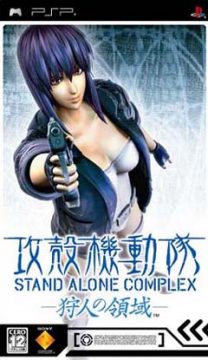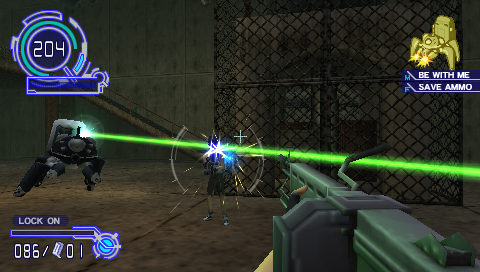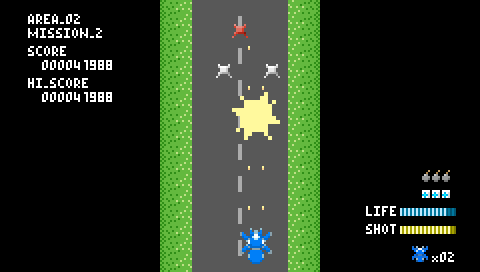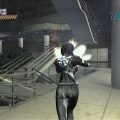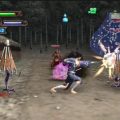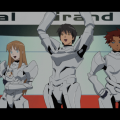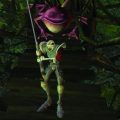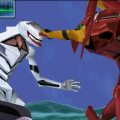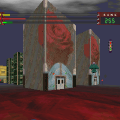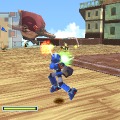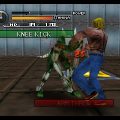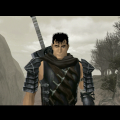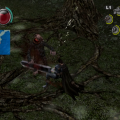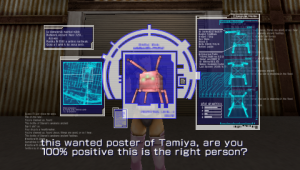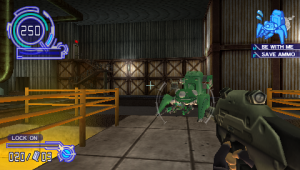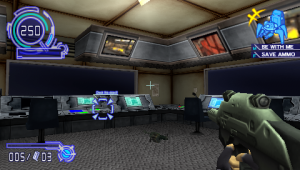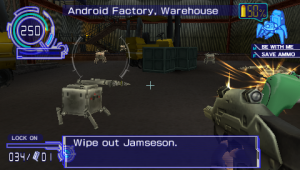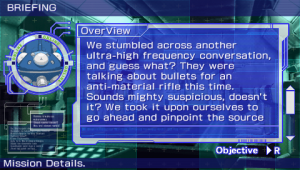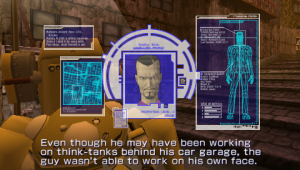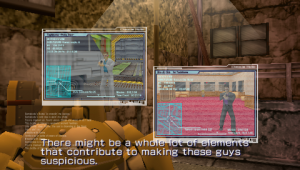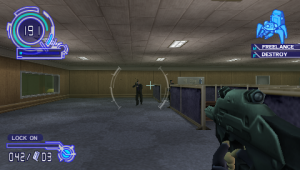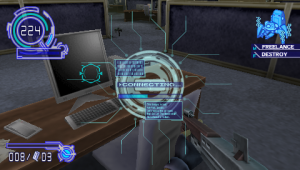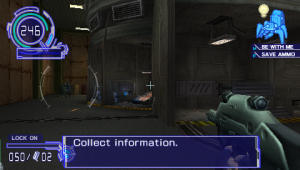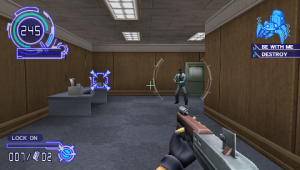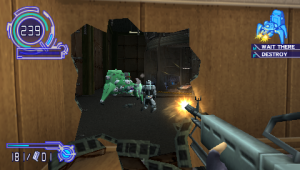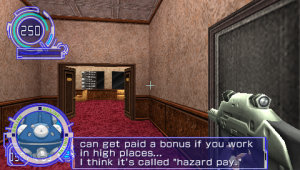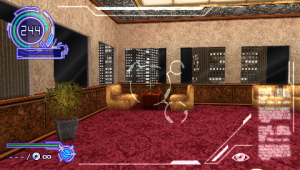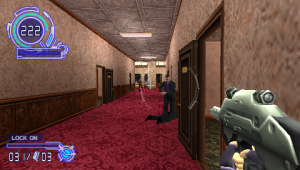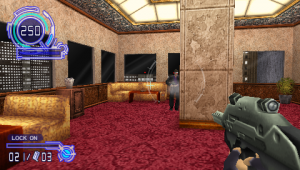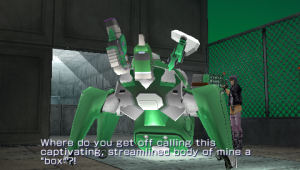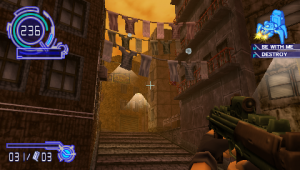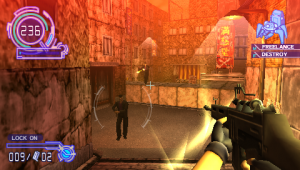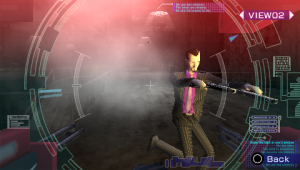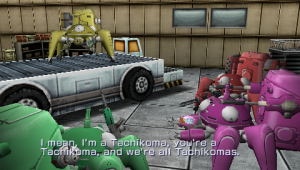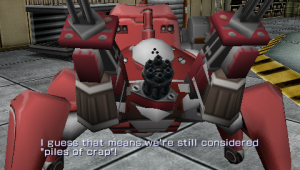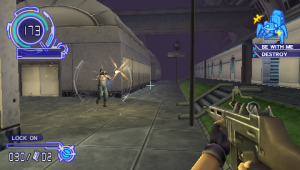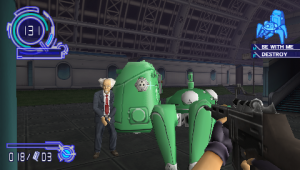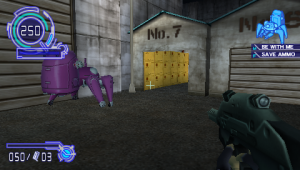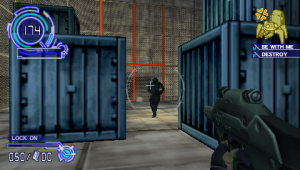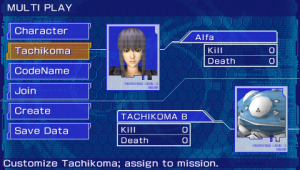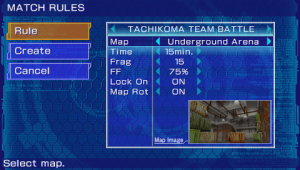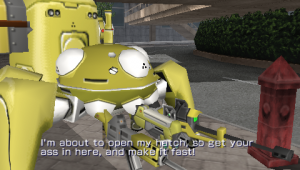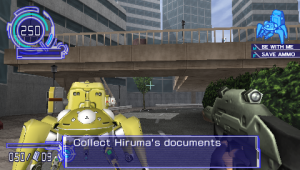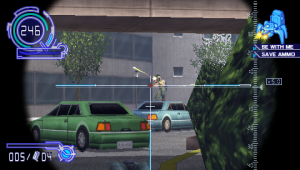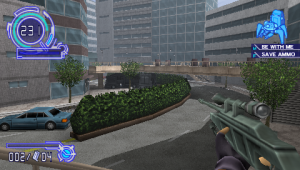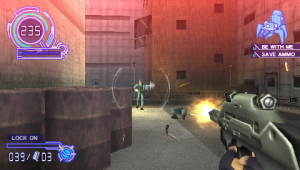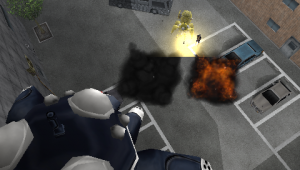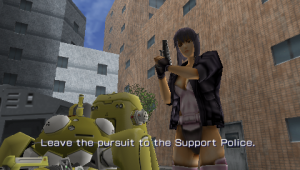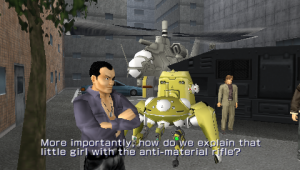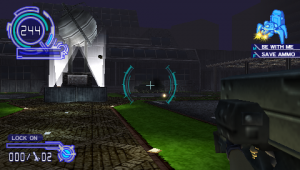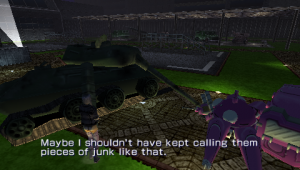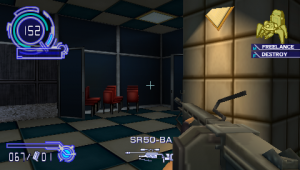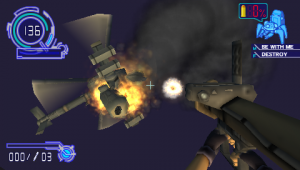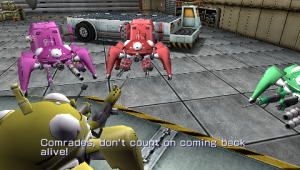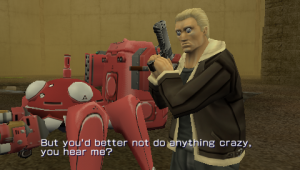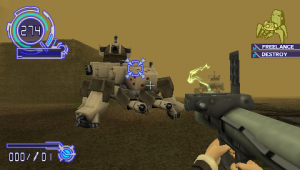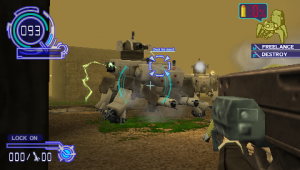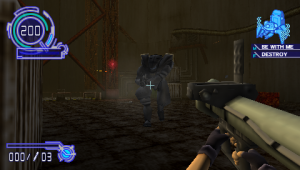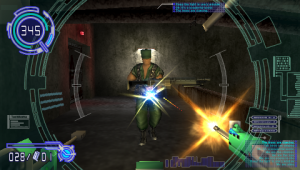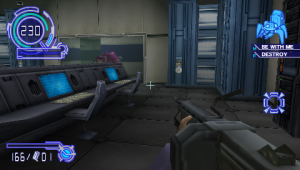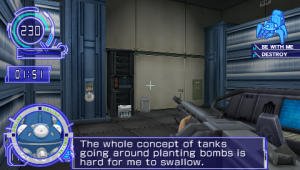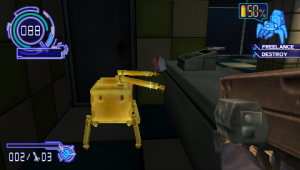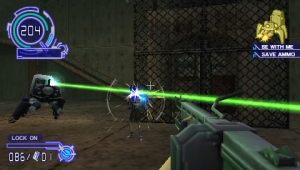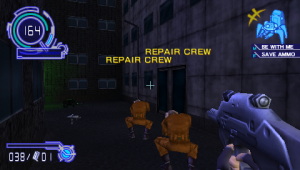- Ghost in the Shell (PS1)
- Ghost in the Shell (PS2)
- Ghost in the Shell: Stand Alone Complex (PSP)
- Ghost in the Shell (Mobile Phones / Pachinko)
Developed by obscure company G-Artists (whose biggest claim to fame seems to be PS1 shoot-em-up Philosoma and the Kurushi puzzle games), and assisted by Production IG, GitS: SAC for PSP came out less than a year after the system’s Japan launch. Its European release came out just a couple of months after the PSP in that region. In a surprise move it is radically different to both the PS1 and PS2 games which came before, styling itself more as a first-person shooter than a third-person action platformer. In Japan it was subtitled Hunter’s Territory to differentiate it from its PS2 predecessor. Ironically, if Mobygames is to be believed, Kurushi also saw the involvement of second-party developer Sugar & Rockets, which apparently was formed from Exact, the company behind the original GitS on PS1. Implying… no real connection at all, but is fun trivia nonetheless.
The game’s reception was mixed, depending on who you speak to, with most critics hating it, and an eclectic list of responses from players. To be honest, it’s really not bad at all. In fact, SAC for the PSP stands as a great example of how unreliable professional reviewers can be, with no consensus at all even for basic things. Some claim the story is the best part, while for others it’s the worst. Gamespy hilariously condemns it for not having a map, despite the map being prominent, accessible via the Select button, extremely useful, and essential when ordering your Tachikoma around. It’s almost as if some reviewers booted the UMD, played the first level for five minutes and then used PR supplied screenshots to knock out a review without any real knowledge of it. The game isn’t without its flaws, and there are legitimate reasons why some could consider it the weakest of the GitS trilogy, but in several ways it’s also better than its two predecessors. For the author of this expansive article, SAC is a damn fine game, perhaps surpassed on the PSP by newer action titles but still an excellent contender.
Although by a different developer and on different hardware, SAC on the PSP is pitched as a direct follow-up to SAC on the PS2. It’s also intended to integrate directly into the anime series. What starts off as a routine interception of terrorists breaking into the national archives quickly escalates into a complex conspiracy, with several twists, again involving the Far North’s fight for independence, which was touched upon in the previous game. There’s also a sub-plot detailing the creation of the Tachikoma units. As explained by Masao Tsuda, assistant producer at SCEJ, in an interview with IGN: “The script was written by Production IG, who was involved in SAC [the anime series]. Based on the series, the story and the investigation of incidents are very important components of the game. The incident in Niihama, Berutarube, where the current story takes place, also appears in the original Ghost in the Shell by Masamune Shirow. It is also a geographical location that appears in [the second film] Innocence. The storyline follows an incident that occurs in Niihama that ultimately spreads into the city of Berutarube. The city turns into a battle ground involving the government and terrorists.”
Despite looking like an FPS, there’s a strong tactical focus, thanks to four selectable characters (Kusanagi, Batou, Saito, Togusa), a diverse assortment of weapons to collect and equip, plus the Tachikoma themselves, who act as computer controlled partners during play. The constant presence of these robotic AI buddies is what really elevates SAC, since they can be ordered to follow you, go wandering, or stay put, while shooting everything they cross, conserving ammo, or not firing at all. They can also be ordered to head to specific A, B and C locations marked on that level’s map. Additionally, at any point, you can walk up to your Tachikoma and jump inside, using its available weapons and HP, while also gaining increased jumping ability. This is great if you’ve taken a lot of damage and are in a tight spot. The four available Tachikoma are classified as Balanced, Aggressive, Intelligent and Humorous, and together they add some wonderful light relief to proceedings.
To understand the Tachikoma, picture four unique and hyperactive puppies given the power of speech, and then imagine these personalities transplanted into giant mechanical spiders armed to the abdomens with death dealing weaponry. They play a much more prominent role in the story and gameplay than in previous games (despite the analogous Fuchikoma being the player character on PS1), and there’s considerably more high pitched banter than before. The four of them will scheme, joke, chat and get frightened by the silliest of things, while giving a constant commentary to the player during missions. Anyone who watches the first cut-scene featuring the Tachikoma and doesn’t instantly want one as a pet has no heart (or perhaps just hates puppies) – they are utterly adorable. Game Informer’s reviewers were clearly robots themselves to detest them so much. Having said that, the Tachikoma do show up the rest of the game’s characters as being soulless in comparison, though this could just be an ironic “meta” statement regarding the world of GitS.
Another complaint raised by reviewers is regarding the Tachikoma AI, claiming they “steal your kills”, get in the way or are prone to getting lost. This is all nonsense. There’s one fantastic moment in a later level when you’re descending a shaft via an open elevator, with rocket enemies below slowly coming into alignment. Further enemies meanwhile will drop from above. You can set your Tachikoma to roam around taking out these encroaching enemies while you snipe the deadly rocket soldiers before they can fire a single shot. This is the basis of some great team work, and the Tachikoma will function based on your orders and the personality you’ve chosen for them – they are most definitely designed to kill enemies, even if this sometimes feels like a concession for the PSP’s poor controls. Some stages will task you with finding bombs or escorting NPCs, and having a reliable AI to back you up is a glorious thing.
As for them wandering off or getting lost, there will be times when you can’t exit a level because they’re somewhere else but – but! – this only happens if you set it to “freelance” movement or it has a low “loyalty”, such as with the Aggressive model. Pick the timid Intelligent model and set it to “by me” and it’ll be on you like white-on-rice throughout the level. You can’t criticise a game because you’re playing it wrong. The path-finding is surprisingly robust, with an obedient Tachikoma easily able to navigate to your location or ABC points on the map, as long as there are no obstructions. Some levels will have small doorways they can’t pass through, but circumventing these tends to be part of that level’s mission objective. Otherwise the Tachikoma are impressively intelligent and will follow your orders as long as they have high loyalty. Conversely the enemy AI isn’t as polished, and enemy soldiers will happily eat bullets and die, walk into fire, or not notice you for a few seconds when standing in front of them. Still, a weak foe is infinitely preferable to a computer partner who is a liability. How several reviewers can complain the game is too difficult is a mystery, because it’s actually very easy.
There’s also a deep level of customization, for both the player characters and the Tachikoma. Players can equip up to three weapons from an available roster of 51. While only a few are unlocked at first, completing stages unlocks more, while picking up a new enemy weapon and keeping it in your inventory until the stage’s end also makes it available. The selection is more diverse than the PS2 release, with handguns, dual handguns, various sniper and assault rifles, shotguns, bazookas, guided missiles, grenade launchers in addition to several types of grenade, plus more exotic fare such as a railgun and Gatling gun. The Tachikoma meanwhile have over 60 available items to equip on up to five separate attachment points on their bodies. If you find you’re going up against two tanks and a Jigabachi attack chopper, feel free to stick five bazookas to its body and let rip! Alternatively, balance it out with three diverse weapons plus a repair module and extra ammo box. Coupled with some great partner AI, this diverse selection of Tachikoma gear makes for fun experimentation. New Tachikoma parts can be acquired by finding and shooting the gold “Jameson Type” robots hidden on some levels. This adds a small element of replayability and encourages exploration.
There’s a multitude of other really, really, really cool ideas. There are 20 levels comprised of joined sections (for example an underground train yard and station above ground), which are divided between the game’s six chapters – each level is classified as either a sub-mission or a climactic “event mission”. Within each chapter the sub-missions can be tackled in any order, and while all are ultimately mandatory it does mean you can try a different stage if you stuck on one. More games should do this. Once unlocked a mission can be replayed at any time, allowing you to go back to search for hidden weapons. There’s no experience to grind for and no penalties for relying on the Tachikoma to attack enemies, so you can enjoy stages quite leisurely. Of the 20 available only about three use recycled environments, giving the game more variety than the previous two games.
Several levels also have an unconventional goal. There’s the aforementioned bomb tagging and NPC escort levels, which are entirely painless thanks to some top notch partner AI, plus there are several involving the hacking of various computers. In addition there’s a section of a level where you’re not in control at all, but are required to kit out your chosen Tachikoma and send him out to do battle (clearly the Aggressive model is best in this situation). It’s not a very long or complex section, but this mini slice of Robot Wars helps break up the pace, and is representative of one of the multiplayer modes. Other levels prevent you from hiding inside your Tachikoma because they’re escorting a key NPC inside them to safety (cue some humorous dialogue with reluctant NPCs who dislike the idea). At other times your Tachikoma will be trapped due to their size, meaning you need to scout ahead, alone, to open the way. In one instance you end up trapped inside a caged arena battling tough enemies, while your Tachikoma is running around the outside of this cage taking out enemy snipers. The duality in these set-pieces is usually really well done, and makes you appreciate having your little puppy-spider-buddy thing to help you out…
Something a lot of players might not even realize, assuming they jump straight into the game, is that every character starts every mission with optic camouflage. It’s single-use only, but accessing the pause menu allows you to activate it at any time, rendering you invisible to all enemies for a while. This is especially handy on some levels where stealth proves beneficial. It’s not quite as well implemented as optic camo was on the previous PS2 game, where it lasted longer and was essential for stopping snipers, but it’s a really nice touch to have access to it any point on PSP, albeit only once per level.
By far the coolest idea, which fundamentally alters how you approach the game, is the realistic reloading and bullet management. Weapons equipped prior to a level come with a preset amount of ammo and spare magazines, which can never be replenished; there are no ammo pickups ever. If you fire 10 bullets from a magazine containing 50, and then reload from a pool of three magazines, the remaining 40 bullets inside the gun are discarded and you’re left with only two spare magazines. Apart from blowing the idiotic “magic gun feeder” principle used in every other FPS right out the water, this fosters an intensely strategic logic in reloading. Wasting five bullets from a magazine that holds ten times as much isn’t a problem – but if a sniper rifle can only hold five bullets at a time, each is precious. The only way to get more ammunition is to discard your held weapon for one dropped by the enemy. But here’s the ingenious thing: every bullet fired by an enemy prior to dropping their weapon is remembered and reflected when you pick it up. Take them by surprised and it’ll have a full compliment of bullets and magazines; trade potshots for a while and there might not be much to work with. How many times have you played a game where you engage an enemy who fires dozens of shots, afterwards retrieving the gun from their corpse only to discover it has a full compliment of ammo? This is not only unrealistic, it is utterly ridiculous and a sign of lazy design and/or sloppy programming. SAC is the complete opposite of this, with a cohesive and realistic set of logic rules within each level. It cannot be overemphasised how magnificent this set-up is – or how exciting it can make some levels, as you’re running through a trench clutching what precious bullets you have left. Given how few other FPS have realistic reloading, this feature alone makes SAC on the PSP extremely noteworthy.
Other equally excellent ideas unfortunately aren’t pulled off quite as well. A significant criticism of the preceding PS2 release was that the brain-jacking aspect, which was perfectly implemented and a lot of fun, was sorely underused. Once a level really wasn’t enough. This follow-up on PSP heads in the right direction, by allowing you to brain-jack any regular enemy, at any point, as many times as you want, but it completely bungles the purpose of doing so. It’s so utterly, hopelessly useless, it raises the question of what G-Artists’ original intention was. To brain-jack you need to access your weapon inventory (right on the d-pad), go to the stun gun, and use L to change its function to “hack”. Unfortunately brain-jacking can now only be done via line of sight, so you have to be looking directly at an enemy when doing so, meaning they either can or soon will see you and begin attacking. Once you’ve jacked an enemy you can’t actually do anything apart from look through their eyes. Most likely they’ll turn around, spot you, shoot and thereby kick you out of their head. It doesn’t seem possible to control them to attack other enemies, and you can’t kill them while brain-jacked – it also leaves you immobile and open to attack from other enemies, unless your Tachikoma is standing guard. The only function it could serve would be reconnaissance, but since you have to look directly at an enemy to use it, chances are you can already see what they’re seeing. Given how this aspect of the game was overlooked by reviewers, who were so keen to criticize other parts of SAC, it shows just how little attention they actually paid to the game.
While this write up paints an extremely positive picture of SAC on the PSP, and make no mistake that a lot of the complaints by critics are spurious, there are a few genuine shortcomings which need to be tolerated to appreciate the game. Firstly, the promised depth isn’t as great as it seems. Many of the player and Tachikoma weapons are useless – grenades for example take too long to equip from the side menu and take too long to throw to be useful. The same with the mines. This already cuts out around 10 or so of the promised 51 weapons. Many are also just reskins with slightly improved stats, and whether you use the base shotgun or marginally improved one with a different color, it’s all the same. In truth there’s only about five or so key weapons which you’ll regularly use. As mentioned the hacking weapon serves no function, and neither does the stun weapon, apart from two specific instances where you’re forced to use it. The Tachikoma weapons are a little better, but again there’s only a small set of genuinely useful options.
The same can be said of the four selectable player characters, which offer almost no differences between them. Kusanagi is the all rounder, Batou has slightly more HP, Togusa can run a little faster, but the differences between them are negligible. What makes this especially baffling is that in the interview with Tsuda, he explicitly states that the characters would offer different experiences: “Saito is a character who excels at using the sniper rifle, so for missions where you must go unnoticed by the enemy, he would be an excellent choice. In stages where there are enemy snipers and in city battles, I would recommend using Saito. But since he is not 100% artificial, he is weak against enemy attack, so in this way, the gameplay difficulty level will increase.” Having tested Saito with various sniper rifles, he doesn’t appear to offer any improvement over Kusanagi whatsoever. This lack of difference between characters wouldn’t matter, but the game expects you to finish each level with each of them for 100% completion (so 80 playthroughs rather than 20). Interestingly, each character has uniquely recorded dialogue for the opening and closing scenes of each mission if they’re chosen, which perhaps adds a bit of motivation to the replays, but it seems like a tremendous use of resources for something few players will do. Using extra characters doesn’t unlock much apart from some extra weapons, so if you want you can just stick with Kusanagi for the entire playthrough.
Quite a few places also complain that the environments and level design are lacking – in truth they range from boring to excellent, so it’s more a case of them being a mixed bag. Some indoor levels are just corridor crawls with enemies to kill, while some of the outdoor stages feel cramped like the indoor ones. These levels aren’t much fun. Contrasting against these are some really special set-pieces though. The one where you chase down the robot maid requires you to abandon lethal weapons in order to stun her, while also avoiding hurting civilians milling about – watching them cower in fear is a nice touch. It’s a good idea to order your Tachikoma to stop firing altogether, because if it hits a civilian it’s game over. There’s also the aforementioned elevator descent, where you need to focus on sniping enemies below before their rockets are in range, and another mission where you have to fight against two tanks amidst historical memorabilia and then an attack chopper. The stage where you run around a series of trenches, popping out randomly to take potshots at some enormous robots, is also a fantastic highlight. The little “Jameson Type” robots hidden throughout meanwhile encourage exploration, with some maps being rather maze-like. Unfortunately, there’s little environmental interaction. There’s no windows to shoot out, boxes don’t break, and it all feels like a series of invincible sets. The one exception being cracked walls, which can be knocked down with explosives. Though seeing as no one seems to care about this in other games, perhaps it’s no big deal… Overall the stages have been designed to suit the PSP and shorter play times – none of them are as long as the levels in the PS2 game, which can only be a good thing.
The big hurdle for many will be the controls, since without a second analogue stick you have to “look” using the rightside face buttons. Annoyingly you’re not allowed to customize the controls, and of the four preset control layouts only the default is anywhere near functional. They go as far as allowing you to switch the analogue sick and d-pad functions around, but they won’t let you customize it by switching analogue/d-pad functions over to the face buttons, so you can look with the analogue stick (which should familiar to Goldeneye veterans). Having said that, it’s not quite a game breaker, and is the reason why at the start of this article SAC was described as being more tactical than straight FPS. There are never more than a couple of enemies, movement is deliberately slow, and it can’t hope to compete with a twitch-based FPS. Which is why there’s a focus on good equipment selection, customizing your Tachikoma, and then giving him specific instructions on where to move to and who to shoot. You’re not meant to engage enemies that spawn near you as if you’re playing Halo – in the few areas where this happens, you’re meant to order your Tachikoma to stand its ground and fire at everyone, while you deal with secondary objectives. Significantly there’s also a lock-on button, via down on the d-pad. A quick tap automatically focuses your aim on the nearest enemy, allowing you to bypass the trickeries of manual aiming. Some might say it’s a design cheat, but given the hardware’s limitations it functions adequately at removing much of the stress you’d otherwise have.
Given the wide range of opinions for SAC online (and there is a vocal group who really like it), your mileage will vary depending on how well you can tolerate its generally minor flaws in order to enjoy its better aspects. Traditionally the FPS genre has been a benchmark for new hardware, showcasing what it’s capable of. As such, they usually try to be the best within their given sub-category or sphere. Even when they don’t, such as with the multitude of generic examples released, they try to ape the best in the genre in the hoping of finding some niche appeal. This would fail with the PSP, which isn’t suited to the genre. Instead, SAC is built within the framework of an FPS, but tailored to the limits of the hardware. From the controls, which feature a lock-on button, to the design which includes an AI assistant, a focus on hacking terminals rather than gunplay, and the ability to engage an invisibility cloak at any time. This won’t appeal to everyone, but SAC is a solid title regardless.
For the PSP there aren’t that many better action games available, and it makes a nice change from Peace Walker or Valkyria Chronicles II. If you can find another PSP owner with a copy of the game you can also try the multiplayer. We haven’t tested it, but it seems one of the modes allows you and a friend to send your customized Tachikoma into the arena to fight, controlled entirely by the AI. It’s a shame this mode isn’t accessible in single player, because it sounds like a most enjoyable Robot Wars style diversion.
Sadly GitS: SAC seems to have been the game that killed G-Artists, because they have no further listings on Mobygames.
This is awesome. Finish the game and you unlock a neat little minigame featuring the Tachikoma in a vertically scrolling 2D shoot-em-up. Jameson Robots and debris such as logs constantly scroll down from the top of the screen and must be destroyed, while you try to avoid indestructible rocks. You have limited ammo which continuously recharges, along with three super bombs and three health recharges. The health packs can be used when your HP gets low due to colliding with the Jameson robots (hit a rock and you lose a life though). Occasionally there’ll be a bomb or health pick-up item. It’s really simple and quite easy, but a lot of fun. Although it may resemble something like Spyhunter, the fact that you can only move left and right, without altering the vertical scrolling speed, makes it feel more like Space Invaders, albeit with a moving background. More games should include unlockables such as this!
